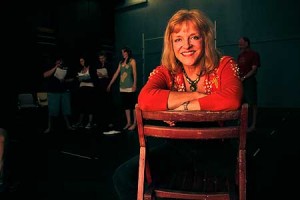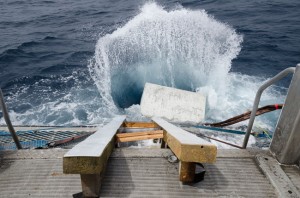Massey Senior Lecturer Thom Conroy’s historical novel is reviewed on Afternoons by Mary McCallum: http://www.radionz.co.nz/national/programmes/afternoons/audio/20157707/book-review-with-mary-mccallum.
Category Archives: Creative Writing
Australasian Association of Writing Programmes (AAWP) Conference
From 30 November to 2 December 2014 Massey University hosted the 19th Annual Australasian Association of Writing Programmes (AAWP) Conference at the Massey Wellington campus (http://www.aawp.org.au/19th_annual_conference). The conference featured three New Zealand keynote speakers: playwright and screen-writer Hone Kouka, novelist Emily Perkins, and creative non-fiction writer Martin Edmond. Other major events at the conference included the Wellington launch of Poetry New Zealand, now edited by Jack Ross at Massey University, as well as the launch of the Aotearoa Creative Writing Research Network (ACWRN). Martin Edmond’s keynote talk also dovetailed with the opening of the Placing the Personal Essay Colloquium (http://placingthepersonalessay.weebly.com), co-organised by Ingrid Horrocks of Massey University and Cherie Lacey of Victoria University.
This is only the second time that the Australasian Association of Writing Programmes conference has been hosted in New Zealand, and conference co-organiser Thom Conroy said, “This event marks an important development for collaborations and conversations between creative writers in New Zealand and Australia”. Other conference organisers included Gail Pittiway from Wintec as well as Ingrid Horrocks and Hannah Gerard of Massey, Wellington. Nick Allen, a Massey PhD student in literature at the Palmerston North campus, served as executive conference coordinator
Minding the Gap: Writing Across Thresholds and Fault Lines
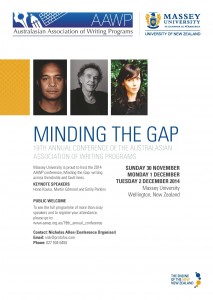 AAWP 19th Annual Conference 2014
AAWP 19th Annual Conference 2014
30 November- 2 December
Massey University
Wellington
The Australasian Association of Writing Programmes (AAWP) was established in 1996, and it is now the most important forum in Australia for discussing all aspects of teaching creative and professional writing as well as for debating current theories on creativity and writing.
‘Minding The Gap’ is only the second AAWP conference to be held in New Zealand.
Keynote speakers: Hone Kouka, Emily Perkins, Martin Edmond.
The new Poetry New Zealand journal will also be launched from 6.00pm-7.30 pm on December 1 at Meow Café, 9 Edwards St, Te Aro, Wellington.
Congratulations Leleiga for scholarship win!
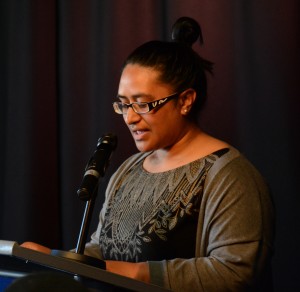
Leleiga Taito reads her work at a recent Creative Writing Student Writers Read event at Massey Wellington campus.
Congratulations to Expressive Arts student Leleiga Taito who has just been announced as the winner of a $5000 scholarship to research safety communication on Mt Ruapehu in 2015.
Leleiga is currently finishing her final year of the Bachelor of Communication (Public Relations and Expressive Arts), and will start postgraduate studies (BC Honours) in 2015. Her Honours research project (supervised by the School of English & Media Studies and co-funded by GNS and Massey University through the Joint Centre for Disaster Research) will be a real-world life-saving project that looks at how to improve safety awareness for mountain users, particularly about the risks of lahars and avalanches.
Leleiga will have the opportunity not only to investigate practical safety communication challenges in depth, but also to develop creative multi-media solutions to the communication challenge. She has past experience of similar projects during her Bachelor of Communication (BC) studies, and will now extend these skills in-depth with her Honours research.
Leleiga’s prior study achievements include creative writing, digital media production, media releases, strategic communication plans, and service learning for community organisations. For example, she created an awareness campaign for the New Zealand Breast Cancer Foundation in her second year of the BC. She says “Through my research I discovered that breast cancer education and prevention messages were not reaching Samoan women. I conducted a mixture of qualitative and quantitative research methods to establish why women in this culture were not receiving these messages. After compiling the information that was gathered I then made suggestions on what appropriate communication strategies could be put in place. I also implemented tactics, where I created four pieces of collateral to encourage Samoan women to have mammograms. One of the communication materials was a web video with Winnie Laban sharing her experiences with breast cancer.” You can see Leleiga’s excellent breast cancer awareness video assignment, with compelling personal interview testimony from Winnie Laban, at http://www.youtube.com/watch?v=MzoX3Nd97so&feature=youtu.be
During her Honours year Leleiga will, under the supervision of her research report supervisor (Associate Professor Elspeth Tilley from the School of English and Media Studies) prepare a comprehensive qualitative investigation of mountain user culture and the communication norms and needs that exist around safety issues. She will have the opportunity to research in the field, living at Mt Ruapehu to gather data during the ski season. Part of her reporting for the research project may also take the form of a creative output (such as a short documentary film) that could in itself provide a useful way to respond to the research challenge by building awareness of relevant safety issues and responses.
Associate Professor Tilley said Leleiga’s success was indicative of the value of the public relations/expressive arts combination in a communication degree. “Most real-world research problems or workplace communication challenges are multi-faceted, and need both a scientific and a creative response to generate understanding and solutions. I think we are really seeing, with the success of our Bachelor of Communication students who all have both a business and a humanities preparation, just how valuable this is for the next steps after a three-year degree, whether that step is further study or the workplace.”
Associate Professor Tilley said study of Expressive Arts (which can include diverse combinations of different digital media production, creative writing and theatre papers) was proving particularly useful for students. “We live in a multi-modal world. Seldom is any public communication these days just a written brochure or poster. Inevitably there are multi-media and social media dimensions. And the work that students do in learning scripting, dialogue, filming, directing, lighting, editing and a whole range of production, post-production and performance-related skills in Expressive Arts sets them up really well for this kind of work after graduation.”
Leleiga’s scholarship includes $5000 for fees and stipend, plus additional coverage of direct costs of her research including accommodation and other research expenses covered at Mt Ruapehu. Other BC students have also been involved in the wider research project – click here for a previous story about the project and click here for a link to a Radio New Zealand story about the project.
Arts on Wednesday – Student Writers Read
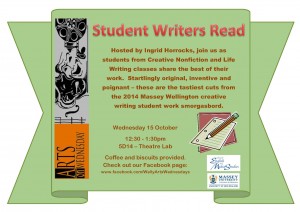 Hosted by Ingrid Horrocks, join us as students from Creative Nonfiction and Life Writing classes share the best of their work. Startlingly original, inventive and poignant – these are the tastiest cuts from the 2014 Massey Wellington creative writing student work smorgasbord.
Hosted by Ingrid Horrocks, join us as students from Creative Nonfiction and Life Writing classes share the best of their work. Startlingly original, inventive and poignant – these are the tastiest cuts from the 2014 Massey Wellington creative writing student work smorgasbord.
Wednesday 15 October
12:30 – 1:30pm
5D14 – Theatre Lab
Coffee and biscuits provided.
Check out our Facebook page: www.facebook.com/WellyArtsWednesdays
Mega-month of activity for August research roundup
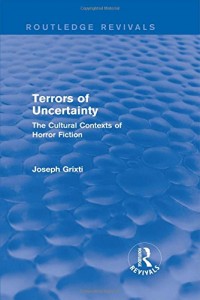
Associate Professor Joe Grixti’s book Terrors of Uncertainty has been re-released, along with other classic humanities texts, as part of the Routledge Revivals series
From Gothic and horror fiction to e-waste and the grand successes of The Naturalist, it’s been another very busy month for EMS research and scholarship – check out our news in this latest Research Roundup!
• Dr Erin Mercer co-edited a special issue of M/C – A Journal of Media and Culture on the Gothic, and published an article on the difficulties faced by contemporary New Zealand writers attempting to use the Gothic genre without reactivating colonialist tropes of haunting Maori, skeletal remains and a Gothicised New Zealand landscape. In the issue’s editorial, titled ‘Gothic: New Directions in Media and Popular Culture’ Dr Mercer and co-editor Dr Lorna Piatti-Farnell of AUT discussed the continuing importance of the Gothic mode in contemporary culture and how that mode is constantly evolving into new forms and manifestations. They argued that the “multi-faceted nature of the Gothic in our contemporary popular culture moment is accurately signaled by the various media on which these special issue essays focus, from television to literature, animation, music, and film. The place occupied by the Gothic beyond representational forms, and into the realms of cultural practice, is also signaled, an important shift within the bounds of Gothic Studies which is bound to initiate fascinating debates. The transformations of the Gothic in media and culture are, therefore, also surveyed, so to continue the ongoing critical conversation on not only the place of the Gothic in contemporary narratives, but also its duplicitous, malleable, and often slippery nature”. Check out the special issue at http://journal.media-culture.org.au/index.php/mcjournal/showToc/current along with Dr Mercer’s article on Supernaturalism and Settlement in New Zealand Gothic Fiction – tantalisingly titled “A deluge of shrieking unreason” at http://journal.media-culture.org.au/index.php/mcjournal/article/viewArticle/846
• Dr Radha O’Meara and Dr Alex Bevan were co-organisers of a symposium entitled Loops and Splices: Changing Media Technologies, on August 1st 2014. The symposium explored a recent turn in media scholarship that uncovers the overlooked and under-examined media technologies that contribute to historical and contemporary practice. Papers looked at how different media technologies have functioned in relation to historical and social practices, aesthetic traditions and specific cultural moments. Keynote speaker Prof Ian Christie (Anniversary Professor of Film and Media History at Birkbeck College, University of London) presented on ‘Denying depth: uncovering the hidden history of 3D in photography and film.’ English and Media Studies staff were also well represented as presenters at the symposium (more below). You can see EMS staff member Dr Sy Taffel’s blog about the symposium at http://mediaecologies.wordpress.com/
• Dr Sy Taffel presented a paper entitled “ArchEcologies of Ewaste” at the Loops + Splices Symposium. The paper explored how media archaeology and media ecologies can be complementary methods in examining a range of issues pertaining to materiality and the damaging effects of the toxic digital detritus that we discard. He focused particularly on ewaste in New Zealand, where there currently is no mandatory (or even free) nationwide ewaste collection scheme, unlike in the EU where the WEEE directive mandates that all ewaste is recycled in high tech local facilities. More than 80,000 tonnes of ewaste annually enter New Zealand’s landfills, adding noxious elements like mercury, arsenic and lead to the soil and water table. Dr Taffel argued that ideas from media archaeology (a way of exploring past technology with a view to creatively reassembling and reusing technology rather than seeing earlier products as obsolete) combined with media ecologies (a reincorporative model of cyclical technological redesign) could point us towards a new age of ‘repair’ ethos, where waste was reduced and new designs resulted from the creative clash of old and new. You can see Dr Taffel’s presentation at http://prezi.com/iap-xqlsvb2o/archecologies-of-e-waste/
• Dr Kevin Glynn presented on “Technologies of Indigeneity: Māori Television and Convergence Culture,” a research focus that has emerged out of his Marsden-funded project working with Dr Julie Cupples (University of Edinburgh) on ‘Geographies of Media Convergence: Spaces of Democracy, Connectivity and the Reconfiguration of Cultural Citizenship.’ Dr Sy Taffel reports on his blog that “the paper focused on New Zealand media representations of the Urewera raids of 2007, and a more recent case where Air New Zealand, who prominently feature Maori iconography in their branding, terminated an interview with a woman for having a ta moko (traditional body markings), which they claimed would unsettle their customers. The paper explored impacts associated with the introduction of Maori TV and social networking software such as Facebook and Twitter on the ability of Maori to represent themselves and partake in mediated debates surrounding cultural identity”.
• Dr Allen Meek presented at Loops and Splices on “Testimony and the chronophotographic gesture.” The paper addressed the role of gesture in Holocaust testimony. Specifically it looked at some sequences from Claude Lanzmann’s long documentary film Shoah. Dr Meek argued that most scholarship has tended to discuss this film in terms of the transmission of the trauma of the Holocaust from the survivor to the viewer. Instead, he drew on the Italian philosopher Giorgio Agamben’s essay on gesture to develop a different reading of Shoah. Agamben argues that photography and the moving image have taken the autonomy of human gesture away from the individual person. When human gestures and movements are recorded they become a form of visual information that can be used for purposes of political control and economic exploitation. Dr Meek’s paper showed how Holocaust testimony forms part of a larger history of recorded gesture in the cinema that we need to consider if we are to understand its relation both to the Nazi system of power and to our recording and viewing of testimony today.
• In other recent research highlights, Associate Professor Joe Grixti’s book Terrors of Uncertainty: The Cultural Contexts of Horror Fiction has been re-released as part of Routledge’s ‘Revivals’ series of classic and important books. Routledge Revivals is a programme designed to reissue a wealth of out-of-print and unavailable titles written by some of the leading academic scholars of the last 120 years. To date, the programme includes titles by the likes of Sir Andrew Motion, Hermione Lee, Zygmunt Bauman, Karl Jaspers, Malcolm Bradbury, Simone Weil, Emile Durkheim, Charles Kindleberger and W. Arthur Lewis, now along with our own Head of School of English & Media Studies, Dr Grixti. Terrors of Uncertainty covers horror fiction from Frankenstein and Dracula to Psycho and The Chainsaw Massacre, illustrating how horror fiction has provided our culture with some of its most enduring themes and narratives. In selecting the text for reissue Routledge notes that: “Considering horror fiction both as a genre and as a social phenomenon, Joseph Grixti provides a theoretical and historical framework for reconsidering horror and the cultural apparatus that surrounds it. First published in 1989, this book looks at shifts in the genre’s meaning – its fascination with excess, its commentaries on the categories and boundaries of culture – and at interpretations of horror from psychology, psychoanalysis, sociology, cultural and media studies”. Terrors of Uncertainty brings together a provocative range of perspectives from across the disciplines, which combine to raise important questions about the relationship between fiction and society, and the way in which we use fiction to resolve or evade our fears of uncertainty. Available in both hardcopy and e-book at: http://www.routledge.com/books/details/9781138794511/
• Essential New Zealand Poems: Facing the Empty Page was recently published by Random House featuring work by a number of staff and PhD students from the School of English and Media Studies: Dr Ingrid Horrocks, Dr Jack Ross, Tim Upperton, Sarah-Jane Barnett, and Aleksandra Lane. Ingrid Horrocks and Aleksandra Lane were named by reviewer Philip Matthews in the Dominion Post as two of half a dozen of “the best of a new and younger generation” of poets to whom readers should “Pay attention now and in the future” (Your Weekend, Dominion Post, 5 July 2014, p. 27). For more information, go to the publisher’s site at http://www.randomhouse.co.nz/books/siobhan-harvey-harry-ricketts-and-james-norcliffe/essential-new-zealand-poems-9781775534594.aspx
• A launch event for Essential New Zealand Poems – Facing the Empty Page held at PNCC Library on 7 August featured local poets Johanna Aitchison (former Visiting Artist and Tutor) and Tim Upperton (Tutor and current PhD stuent) in conversation with Harry Ricketts, poet, academic editor, reviewer and cricket writer. Johanna, Tim and Harry discussed and read from the recently published ‘Essential New Zealand Poems’ edited by Siobhan Harvey, Harry Ricketts and James Norcliffe (another former Massey University School of English & Media Studies Visiting Artist).
• A creative essay by Dr Ingrid Horrocks which forms a key part of Maddie Leach’s collaborative conceptual art project if you find the good oil let us know, features until September as part of the Walters Prize exhibition at the Auckland Art Gallery. See our previous post on this fascinating artwork and Dr Horrocks’ involvement here.
• Associate Professor Lisa Emerson along with Massey colleagues from Education and Communication ran multiple workshops in the lower North island for tertiary teachers on Literacy in the Transition to Tertiary Education. These presentations are based on their research, funded by the government’s Teaching and Learning Research Initiative (TLRI) fund, on transitioning into tertiary study through academic literacy development, and were supported by Ako Aotearoa.
• Dr Thom Conroy launched his book, The Naturalist, on Friday 15 August – the book then spent several weeks at Number One in the NZ Bestseller list. See previous post here. See also: Thom’s interview with Kim Hill, available at: http://www.radionz.co.nz/national/programmes/saturday/audio/20145074/thom-conroy-channeling-dieffenbach
• Senior Tutors Joy Green and Tim Upperton launched their books as part of the Kete Series – Manawatu Poetry at the PNCC Library on Poetry Day – Friday 22 August 2014. This series, published by HauNui Press features Joy’s and Tim’s poetry collections as well as that of Leonel Alvarado, School of Humanities. See more here.
• Dr Thom Conroy spoke on the Intersection between History and Fiction in Historical Fiction at Te Papa, 28 August.
• On August 25, two final-year undergraduate Bachelor of Communication students from CoHSS participated, with Associate Professor Elspeth Tilley, in an applied communication research project involving collaboration with Massey’s Joint Centre for Disaster Research, the Department of Conservation and Geological and Natural Sciences. The project, which involves gathering data on Mt Ruapehu to help understand and improve lahar warning and mountain safety communication effectiveness, was reported on Radio New Zealand’s Our Changing World Science and Environment program, see more here.
• Associate Professor Angie Farrow won won ‘Best Drama Script’ for her new play ‘Leo Rising’ at the Auckland Short and Sweet Festival 2014.
Another wonderful review for The Naturalist
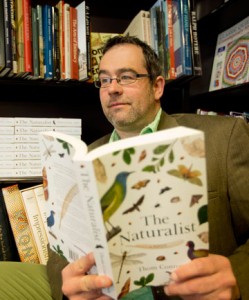 More high praise for Thom Conroy’s best-seller The Naturalist – see the Booksellers’ blog at https://booksellersnz.wordpress.com/2014/09/18/book-review-the-naturalist-by-thom-conroy/
More high praise for Thom Conroy’s best-seller The Naturalist – see the Booksellers’ blog at https://booksellersnz.wordpress.com/2014/09/18/book-review-the-naturalist-by-thom-conroy/
Congrats to Angie
Essay key component of Walters Prize shortlisted artwork
A creative essay by School of English & Media Studies senior lecturer Dr Ingrid Horrocks is currently featuring as part of the Walters Prize exhibition at the Auckland Art Gallery.
The essay forms a key part of Maddie Leach’s collaborative conceptual art project ‘if you find the good oil let us know’, which is a finalist in this year’s Walters Prize, New Zealand’s premier contemporary art award. All four finalists are on display at Auckland Art Gallery Toi o Tamaki until 12 October 2014.
The $50,000 Walters Prize, named after the late New Zealand artist Gordon Walters, is awarded for an outstanding work of contemporary New Zealand art produced and exhibited during the past two years. The prize aims to make contemporary art a more widely recognised and debated feature of our cultural life.
Dr Horrocks’ work of critical-creative prose is the closing piece in the publication, ‘if you find the good oil let us know’, which is the culmination of Maddie Leach’s 2012 Govett-Brewster Aotearoa New Zealand Artist in Residence project of the same name. The project as a whole unfolds an imaginative narrative of whales, cement, art works, scientists, seafarers, migrations, and oil companies via a community of letter-writers and readers.
Dr Horrocks’s contribution works both as part of the artwork, and as the single critical response to the work as a whole. It also involves a recorded performance of her work, which serves as the audio narrative of the project in its next incarnation online in association with the Walters Prize exhibition at the Auckland Art Gallery.
Maddie Leach is a senior lecturer and postgraduate coordinator for fine arts, in Massey University’s Whiti o Rehua – The School of Art at Wellington.
Link: http://maddieleach.net http://www.aucklandartgallery.com/media/6032904/twp2014_catalogue.pdf
The Kete Series – Manawatu Poetry Book Launch
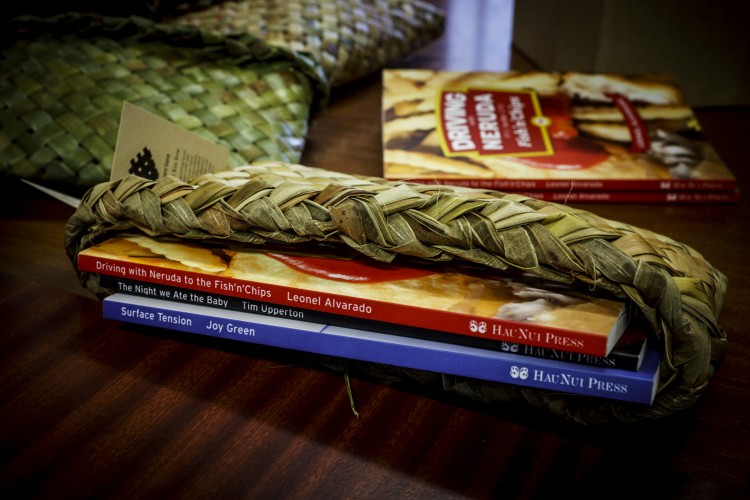
Two of our senior tutors are having a book launch tomorrow. Tim Upperton and Joy Green are being celebrated for their collections of poetry entitled ‘The Kete Series – Manawatu Poetry’ tomorrow night (Friday) at the City Library, Palmerston North at 5.30.
Poetry, publishing and a ‘back-to-basics’ approach to doing business come together this Friday night when three Manawatū poets (and their books) shake off their dust-jackets to reveal the colour and creativity that ‘thinking local’ can bring to our community.
Award-winning weavers-of-words Tim Upperton, Joy Green and Leonel Alvarado along with HauNui Press, Swampthing Magazine and the Palmerston North City Library present an evening of poetry readings, music and mild mayhem – all in the name of National Poetry Day. Starting at 5.30pm, this launch of the new Kete Series home-grown poetry books is just one of the more than 60 events being held around the country to celebrate National Poetry Day. Reading poems from their books, Tim, Joy and Leonel, will in turn recite, excite and reunite audiences on the night with all that poetry can offer.
For the poetry lover, the three books will be available in a limited edition ‘basket set’. Cradled in a kete crafted by local Manawatū weavers, according to publishers HauNui Press “it’s the ultimate traditional tote packed full of juicy poetry goodness!”. In a press release David Lupton, event organiser of Palmerston North-based boutique publisher HauNui Press, noted that ‘We’ve come to think of our approach to book-making as ‘slow publishing’! Along the lines of the ‘slow food’ movement, slow publishing looks to support our local economy by using suppliers in our backyard and respecting the relationship side of transactions, kind of like the way local markets support gate-to-plate dealings between home cooks and growers. For us, it’s the ink-slinger to book-lover connections that are key.’ The books retail for $20 a copy and $80 for a limited edition ‘Kete Set’, which bundles the three titles together inside a traditional tote. The publishers spurned traditional boxed book sets in favour of beautiful flax kete woven specially for the project by another talented local group, Raranga Manawatū, based out of the Highbury Weaver’s Centre. Books and Kete Sets will be available at the launch or from all good booksellers nationwide (or online at www.haunuipress.co.nz) after 22 August.
- What: Book launch
- Where: the Palmerston North City Library
- When: 5.30pm on Friday 22nd August – National Poetry Day.
For more information read this article in this weeks Tribune http://thetribune.realviewdigital.com/?IID=99786&STARTPAGE=PAGE0000001&ArticleTitle=294068#folio=1
Or, visit the event page for the launch on Facebook: https://www.facebook.com/events/508914752585277/
